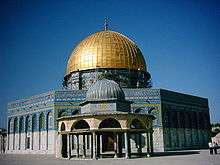Fountain of Qasim Pasha
The Fountain of Qasim Pasha (Arabic: سبيل قاسم باشا) also known as the Fountain of the Bitter Orange (al-Naranj Sabil) is an ablution and drinking fountain located in the western esplanade of the Al-Aqsa Mosque compound in the Old City of Jerusalem. It is situated in front of the Chain Gate.[1]
History
The fountain was built by Qasim Pasha, the Ottoman governor of Jerusalem in 1527 during the reign of Suleiman the Magnificent, making the first public structure to be built on the Haram al-Sharif/ Al-Aqsa Mosque by the Ottomans. Earlier Ottoman works on the site were not the construction of newer buildings but the restoration of the walls.[2] The Sebil (fountain) originally got its water supply from a water channel, but today it is supplied with water from the Masjid al-Aqsa's water system[3].
A wooden colonnade was added to protect the benches and steps surrounding the Fountain of Qasim Pasha from rain and the summer-time sun in the 1920s restoration by the Supreme Muslim Council. The Dome was rebuilt during the restoration, and covered with lead panels that bestowed upon it a pointed shallower profile. In 1998, the lead sheeting was replaced by a finely crafted stone.[2]
There are 16 faucets in the dispenser. This dispenser is also called "Court Gate dispenser".Sabil Qasim Pasha (Qasim Pasha Fountain), also known as Sabil Bab Al-Mahkama (Fountain of the Palace House) and Sabil Bab Al-Naranj (fountain of the bitter orange), is the first Ottoman public building to be built in Jerusalem. The earlier works were not new buildings, but the restoration of the wall and the conversion of the Jerusalem fortress into the Masjid Al-Nabi Dawud (Mosque of the Prophet David). The function of Sabil November Pasha, like other sabiles, was to supply fresh water to the public for drinking and ablutions. There are accounts that Sabil was in use until the late 1940s.
Architecture
The fountain consists of an octagonal building over a cistern, around which is a wooden shelter that protects worshippers from the sun and the rain while performing ablution. There are eight water taps at the fountain, one on each side of the octagon, which are still used for ablution. The fountain structure, enclosing a cistern, is sunk about one meter below the Al-Aqsa Mosque platform. The structure is preceded by a square shallow pool, with marble paving and a modern fountain in its center. The dome of the structure is built atop an octagonal drum.[1]
The dome was rebuilt during restoration by the high Muslim Council in the 1920s and covered with lead panels, giving it a pointed shallow profile. In the final restoration, in 1998, lead cladding was removed and a handsome finely crafted stone dome was uncovered.Sabil Qasim Pasha is unique in its design and differs from other Jerusalem and Al-Aqsa Mosque Sabils. The Aqsa Mosque is the first monument built during the Ottoman period. Therefore, prior to the famous projects of Sultan Suleiman Al-qanuni (Suleiman I), they included the restoration project of the Al-Aqsa Mosque, the Sabills (drinking water fountains), the wing (canal) of Sabil and The Jerusalem Wall. The Sebil originally received its water from a water channel or aqueduct, but today water is supplied through the Al-Aqsa Mosque water system.
South of Sabil Qasim Pasha is a small Mastaba (elevated platform) called the mosque-mestaba Sabil Qaitbay, founded by Ashraf Abu al-Nassar in 860 CE. Sebil is located north of Qaitbay. The rectangular mastaba-mosque also has a mehrab (review).[4][5][6]
References
- Qasim Pasha Sabil Archived 2011-05-25 at the Wayback Machine Archnet Digital Library.
- Al-Aqsa Guide Friend of al-Aqsa 2007. Archived October 6, 2008, at the Wayback Machine
- "Sabil Qasim Pasha". Madain Project. Retrieved 26 May 2019.
- https://www.davamizkudus.org/kudus-video/kasimpasa-sebili-kudusun-taslari/. Missing or empty
|title=(help) - "Mescidi Aksa Rehberi" (PDF).
- https://madainproject.com/fountain_of_qasim_pasha. Missing or empty
|title=(help)

